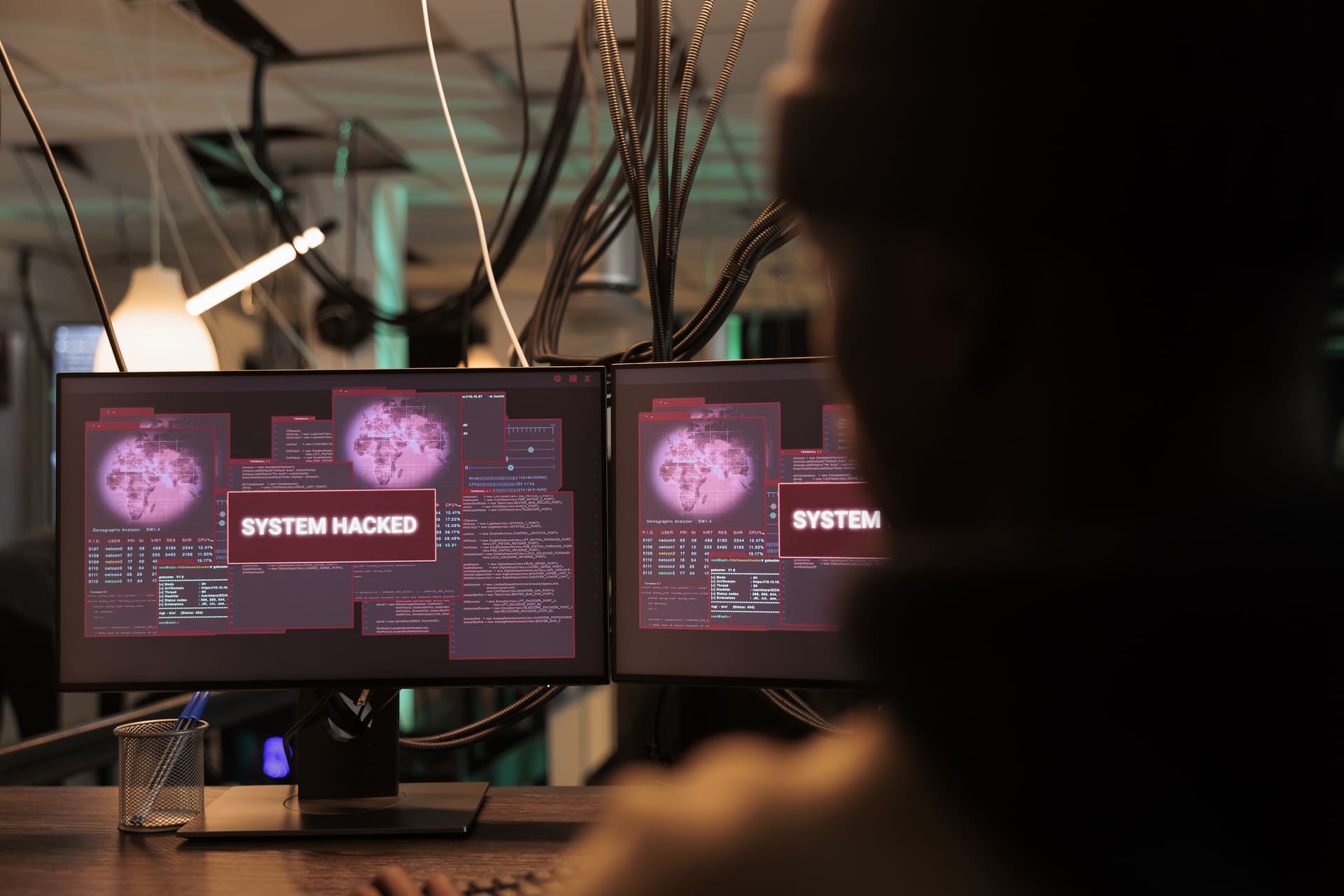Cybersecurity has never been more critical for businesses of all sizes. Traditional security measures that once protected organizations are now struggling to keep pace with increasingly sophisticated cyber threats. Every day, small and medium-sized businesses face ransomware attacks, data breaches, and network intrusions that can cripple operations and destroy reputations.
We understand how overwhelming cybersecurity can feel, especially when you’re focused on running your business. The consequences of inadequate protection are severe: financial losses, regulatory fines, customer trust erosion, and potential business closure. However, there’s hope on the horizon.
Our cybersecurity solutions provide comprehensive protection tailored to your business needs, combining cutting-edge AI technology with expert human oversight.
What Is AI Threat Detection?
AI threat detection is the use of artificial intelligence and machine learning algorithms to identify, analyze, and respond to cybersecurity threats in real-time.
Unlike traditional security methods that rely on predefined rules and known threat signatures, AI systems can learn from patterns, detect anomalies, and identify previously unknown threats through behavioral analysis and advanced pattern recognition.
This revolutionary approach allows security teams to move from reactive to proactive defense strategies. While traditional security tools wait for threats to match known signatures, AI-powered threat detection systems continuously analyze network behavior, user activities, and system operations to spot suspicious patterns before they become full-scale attacks.
The key difference lies in adaptability. Traditional security systems require manual updates to recognize new threats, but AI algorithms continuously learn and evolve, automatically adjusting their detection capabilities as new attack vectors emerge.
💡 AI flips the script by proactively identifying threats through behavior, not static rules. This enables security teams to contain attacks in their earliest stages, dramatically reducing exposure and response time.
How AI Enhances Traditional Cybersecurity
AI transforms cybersecurity by addressing the fundamental limitations of traditional security approaches:
- Speed and Automation: AI can process millions of data points per second, identifying potential threat indicators faster than any human analyst. This rapid analysis allows for immediate response to emerging threats, significantly reducing the window of vulnerability.
- Advanced Pattern Recognition: AI algorithms excel at identifying subtle patterns and correlations across vast datasets that human analysts might miss. This capability enables the detection of sophisticated attacks that use multiple vectors or evolve their tactics over time.
- Proactive vs Reactive Approach: Instead of waiting for known threats to appear, threat detection system implementations continuously monitor for unusual behavior and emerging attack patterns. This proactive stance helps prevent breaches before they occur rather than responding after damage is done.
- Scalability for Growing Businesses: As your business expands, AI security platforms automatically scale to protect additional devices, users, and network connections without requiring proportional increases in security staff or manual configuration.
| Feature | Traditional Security | AI-Enhanced Security |
|---|---|---|
| Threat Detection Speed | Hours to days | Seconds to minutes |
| Unknown Threat Detection | Limited to signatures | Behavioral analysis |
| False Positive Rate | High | Significantly reduced |
| Scalability | Manual configuration | Automatic adaptation |
| Response Time | Manual intervention | Automated response |
Hypothetical Scenario: A manufacturing facility experiences unusual network activity during off-hours. Traditional security might log this as a minor anomaly, but AI threat detection immediately recognizes the pattern as indicative of advanced persistent threat activity, automatically isolating affected systems and preventing data exfiltration.
The Evolution of AI For Network Security: From Basic Rules to Intelligent Systems
The journey of threat detection technology spans over five decades, each era building upon the limitations of its predecessor. Getting to know this evolution helps explain why AI represents such a significant leap forward in cybersecurity capabilities.
- The 1970s: Rule-Based Beginnings: Early cybersecurity relied on simple rule-based systems that could only identify known threats through predefined conditions. These systems were effective against basic attacks but completely vulnerable to any threat that didn’t match existing rules.
- The 1980s: Signature-Based Detection: The introduction of signature-based detection marked the first major advancement, allowing systems to identify malware by comparing files against databases of known threat signatures. While more sophisticated than rule-based systems, this approach still required constant manual updates and couldn’t detect zero-day attacks.
- The 1990s: Heuristic Analysis: Heuristic-based threat detection emerged to combat evolving viruses and malware. It detects zero-day cyber threats and variants of existing malware by examining suspicious code properties, though it generates high false positive rates.
- The 2000s: Anomaly Detection: Anomaly detection systems improved threat detection by establishing baselines of normal network and system behavior to identify deviations. However, these systems struggled with accuracy and scalability in complex environments.
- The 2010s-Present: AI-Powered Intelligence: Modern AI-driven threat detection represents the culmination of decades of cybersecurity evolution. By combining machine learning, deep learning, and behavioral analysis, AI systems can detect both known and unknown threats with unprecedented accuracy and speed.
This evolution was driven by the increasing sophistication of cybersecurity threats and the limitations of human-dependent security processes. According to the Cybersecurity and Infrastructure Security Agency (CISA), the volume and complexity of cyber attacks continue to increase exponentially, making manual threat detection impossible for most organizations.
⏳ AI represents the logical next step after decades of reactive methods. As each generation of cybersecurity addressed a previous weakness, AI now corrects for manual lag and signature limitations with real-time intelligence.
Types of Threats AI Can Detect and Stop
AI-driven threat detection excels at identifying and mitigating a wide range of cybersecurity threats that traditional security tools often miss:
- Malware and Ransomware: AI algorithms analyze file behavior, system changes, and network communications to identify malicious software before it can execute. This includes detecting encrypted ransomware communications and unusual file encryption patterns that indicate an active attack through malware detection capabilities.
- Phishing and Social Engineering: Natural language processing capabilities allow AI to analyze email content, sender patterns, and communication contexts to identify sophisticated phishing attempts. Phishing detection systems can identify subtle linguistic patterns and sender spoofing techniques that fool traditional filters.
- Insider Threats and Behavioral Anomalies: AI systems establish baseline behavior patterns for each user and immediately flag deviations such as unusual access times, abnormal data transfers, or attempts to access restricted resources. This capability is essential for detecting compromised accounts or malicious insiders.
- Zero-Day Attacks: Unlike signature-based systems, AI can identify previously unknown threats by analyzing behavioral patterns and attack techniques. This capability is essential for protecting against zero-day exploits that have no known signatures.
- Network Intrusions: AI continuously monitors network traffic patterns, identifying subtle signs of lateral movement, command-and-control communications, and data exfiltration attempts that might indicate an active breach.
Hypothetical Scenario: A healthcare practice experiences an employee account that suddenly begins accessing patient records outside normal hours and downloading large volumes of data. Traditional security might log this as unusual activity, but AI threat detection would immediately recognize this as a potential insider threat or account compromise, triggering automatic containment measures.
Additional reading: AI phishing
Real-World Impact: What These Threats Cost Businesses
The financial impact of cybersecurity threats on businesses continues to grow each year. Knowing these costs helps justify the investment in advanced AI-powered protection systems.
Recent industry research indicates that data breaches can cost small businesses millions of dollars, with many organizations facing closure following major incidents. For organizations with fewer than 500 employees, a single breach can result in devastating financial consequences.
The breakdown of breach costs reveals multiple impact areas:
- Direct Financial Losses: Including ransom payments, system recovery, and lost revenue during downtime
- Regulatory Fines: HIPAA violations can result in substantial penalties, while GDPR penalties can reach significant percentages of annual revenue
- Reputation Damage: Many small businesses struggle to recover from major cyberattacks
- Operational Disruption: The average downtime from a ransomware attack can extend for weeks, during which business operations are severely limited
Industry-specific impacts vary significantly across sectors. Healthcare organizations face particularly high breach costs, while financial services and manufacturing companies also experience substantial financial impacts from successful attacks.
For a detailed analysis of data breach costs and their impact on businesses, refer to our comprehensive guide on the cost of a data breach.
Don’t wait for a breach to take action. Contact us at (800) 399-2648 or reach out online to learn how AI-powered threat detection can secure your business and reduce cyber risk.
Alternatively, download our e-book on how to protect your business from a cyberattack by filling out the form below!
Key AI Technologies Powering Modern AI Threat Intelligence
Several advanced AI technologies work together to create comprehensive threat detection capabilities:
- Machine Learning Algorithms: These systems analyze vast amounts of historical and real-time data to identify patterns and predict potential threats. Supervised learning models train on labeled datasets to distinguish between normal and malicious activities, while unsupervised learning identifies anomalies without prior knowledge of specific threats.
- Deep Learning and Neural Networks: Multi-layered neural networks process complex data relationships that traditional algorithms cannot detect. These systems excel at analyzing network traffic patterns, file behaviors, and user activities to identify sophisticated threats that use multiple attack vectors.
- Natural Language Processing: Natural language processing capabilities enable AI systems to analyze text-based communications, including emails, chat messages, and social media interactions. This technology is particularly effective at detecting phishing attempts, social engineering attacks, and insider threat communications.
- Behavioral Analytics: AI systems establish baseline behavior patterns for users, devices, and network segments, then continuously monitor for deviations that might indicate compromise or malicious activity. This approach is essential for detecting insider threats and account takeovers.
- Anomaly Detection: Advanced statistical and machine learning models identify unusual patterns in network traffic, system performance, and user behavior. These systems can detect previously unknown threats by recognizing deviations from established norms.
| Technology | Primary Function | Business Benefit |
|---|---|---|
| Machine Learning | Pattern recognition and prediction | Automated threat identification |
| Deep Learning | Complex data analysis | Detection of sophisticated attacks |
| Natural Language Processing | Text analysis and communication monitoring | Enhanced phishing detection |
| Behavioral Analytics | User and system behavior monitoring | Insider threat detection |
| Anomaly Detection | Deviation identification | Zero-day threat detection |
These technologies work synergistically, with each component contributing specialized capabilities to create a comprehensive security platform that can adapt to evolving threats and protect against both known and unknown attack vectors.
💼 The layered use of machine learning, NLP, and behavioral analytics allows AI systems to process context, a leap beyond simple data scanning. This contextual knowledge is critical for nuanced threat scenarios like social engineering.
Additional reading: AI benefits and risks in cybersecurity
How Machine Learning Threat Intelligence Works in Practice
Knowing how AI threat detection operates in real-world environments helps businesses appreciate its value and effectiveness. The process involves several interconnected steps that work continuously to protect your organization:
- Data Collection and Ingestion: AI systems continuously gather data from multiple sources, including network logs, endpoint activities, user behaviors, email communications, and external threat intelligence feeds. This comprehensive data collection provides the foundation for accurate threat detection.
- Data Processing and Normalization: Raw security data and AI processing systems clean, standardize, and prepare information to ensure consistency across different sources. This step involves filtering noise, correlating events, and preparing data for analysis by machine learning algorithms.
- Pattern Analysis and Baseline Establishment: AI algorithms analyze historical data to establish normal behavior patterns for users, devices, and network segments. These baselines serve as reference points for identifying anomalies and potential threats.
- Real-Time Monitoring and Analysis: Advanced AI algorithms continuously monitor incoming data streams, comparing current activities against established baselines and known threat patterns. This real-time analysis enables immediate threat identification.
- Threat Classification and Prioritization: When potential threats are identified, AI systems classify them based on severity, likelihood, and potential impact. This prioritization helps security teams focus on the most critical threats first.
- Automated Response and Alerting: Based on predefined policies and threat severity levels, AI systems can automatically implement containment measures such as isolating infected devices, blocking suspicious IP addresses, or restricting user access while simultaneously alerting security teams.
- Continuous Learning and Adaptation: AI systems learn from each security event, updating their models and improving future detection capabilities. This continuous learning process ensures that the system becomes more effective over time
Benefits of AI-Driven Threat Detection for Your Business
Implementing AI-powered threat detection delivers significant advantages that translate directly into business value and improved security posture:
- Faster Threat Detection and Response: AI systems can identify and respond to threats in seconds rather than hours or days. This rapid response capability reduces the dwell time of attackers in your network, minimizing potential damage and data exposure. The benefits of AI include dramatically improved response times compared to traditional methods.
- Dramatically Reduced False Positives: Traditional security systems generate thousands of alerts daily, with many being false positives. AI-driven systems significantly reduce false positives, allowing your security team to focus on genuine threats rather than investigating benign activities.
- 24/7 Automated Monitoring: AI systems never sleep, providing continuous protection even when your staff is unavailable. This round-the-clock monitoring is essential for detecting attacks that occur during off-hours or holidays when human oversight is limited.
- Cost-Effectiveness Over Time: While initial implementation costs may be significant, AI systems reduce long-term security costs by automating manual processes, reducing staff workload, and preventing costly breaches. Organizations typically see a positive return on investment within reasonable timeframes.
- Scalability as Business Grows: AI systems automatically adapt to protect additional users, devices, and network segments as your business expands. This scalability eliminates the need for proportional increases in security staff or manual reconfiguration.
Organizations using AI-powered threat detection experience significantly fewer successful breaches and dramatically reduce their mean time to detection. These improvements translate to substantial cost savings and preserved business continuity.
💡 AI gives SMBs enterprise-grade protection that scales with their growth. This flexibility makes AI one of the few cybersecurity investments that delivers increasing returns as businesses expand.
Implementation Challenges of AI Incident Response and How to Overcome Them
While AI threat detection offers significant benefits, organizations must address several implementation challenges to ensure successful deployment:
- Integration with Existing Systems: Many businesses worry about how AI solutions will work with their existing security infrastructure. Modern AI platforms are designed with API-based integration capabilities that connect seamlessly with existing firewalls, endpoint protection, and security information and event management systems. The key is choosing solutions that prioritize interoperability and provide dedicated integration support.
- Staff Training Requirements: Implementing AI systems requires your team to understand new interfaces, alert types, and incident response procedures. However, leading AI platforms are designed for ease of use, with intuitive dashboards and automated workflows that require minimal technical expertise. Most implementations include comprehensive training programs and ongoing support.
- Initial Setup Costs: Budget concerns are valid, but the cost of AI implementation should be compared against the potential cost of a major breach. For small businesses, cloud-based AI security solutions offer affordable monthly subscriptions that eliminate large upfront investments while providing enterprise-level protection.
- Data Privacy Concerns: Organizations often worry about AI systems accessing sensitive data. Reputable AI security platforms implement zero-trust architectures, encryption, and compliance frameworks that protect data privacy while enabling effective threat detection. Look for solutions that maintain data sovereignty and provide transparent privacy controls.
- Choosing the Right Solution: The complexity of AI security options can be overwhelming. Focus on solutions that offer proven track records, transparent pricing, comprehensive support, and integration capabilities that match your existing infrastructure. Consider partnering with experienced cybersecurity providers who can guide your selection and implementation process.
According to NIST cybersecurity framework guidelines, successful AI implementation requires careful planning, phased deployment, and ongoing optimization. Organizations that follow structured implementation approaches achieve faster deployment times and better security outcomes.
AI Threat Detection vs Traditional Security: A Side-by-Side Comparison
Knowing the concrete differences between traditional and AI-enhanced security helps businesses make informed decisions about their cybersecurity investments:
| Aspect | Traditional Security | AI-Enhanced Security |
|---|---|---|
| Detection Speed | Hours to days | Minutes to seconds |
| Unknown Threat Detection | Limited effectiveness | High effectiveness |
| False Positive Rate | High alert volume | Significantly reduced |
| Staff Requirements | Multiple security analysts | Fewer analysts with AI support |
| Scalability | Linear cost increase | Efficient cost scaling |
| Response Automation | Manual intervention required | High automation level |
| Threat Intelligence | Static, manual updates | Dynamic, continuous learning |
| Breach Prevention Rate | Traditional effectiveness | Enhanced effectiveness |
| Compliance Reporting | Manual, time-intensive | Automated, real-time |
💡 The most significant difference lies in adaptability: traditional security systems become less effective over time as new threats emerge, while AI systems become more effective through continuous learning and adaptation.
These differences demonstrate why organizations are rapidly transitioning to AI-enhanced security platforms. The combination of improved effectiveness and reduced operational costs makes AI threat detection not just a security upgrade, but a business imperative.
Ready to enhance your cybersecurity strategy? Contact us today to explore how AI-driven threat detection can protect your business from evolving cyber threats.
Industry-Specific Applications and Compliance Considerations
AI threat detection adapts to meet the unique security and compliance requirements of different industries:
- Healthcare (HIPAA Compliance): Healthcare organizations face stringent HIPAA requirements for protecting patient data. AI systems provide automated compliance monitoring, detecting unauthorized access to electronic health records, and ensuring audit trails meet regulatory standards. The technology also identifies potential HIPAA violations in real-time, enabling immediate corrective action.
- Financial Services (Regulatory Requirements): Banks and financial institutions must comply with regulations like SOX, PCI DSS, and state banking laws. AI-powered systems monitor transaction patterns for fraud, detect insider trading attempts, and ensure data handling meets regulatory standards. Advanced analytics help identify sophisticated financial crimes that traditional systems miss.
- Manufacturing (IP Protection): Manufacturing companies face increasing threats to intellectual property and operational technology systems. AI systems protect CAD files, manufacturing processes, and industrial control systems from corporate espionage and ransomware attacks. The technology provides specialized monitoring for industrial networks and connected devices.
- Professional Services (Client Data Protection): Law firms, accounting practices, and consulting companies handle sensitive client information requiring specialized protection. AI systems monitor document access patterns, detect unauthorized sharing attempts, and ensure client confidentiality while maintaining productivity. Integration with document management systems provides seamless protection without workflow disruption.
Industry compliance frameworks like NIST, ISO 27001, and sector-specific regulations provide guidance for AI security implementation. Organizations report significant reductions in compliance audit preparation time when using AI-powered security platforms with built-in compliance reporting capabilities.
What to Look for in an AI Threat Detection Solution
Selecting the right AI security platform requires careful evaluation of several critical factors:
- Integration Capabilities: The solution must seamlessly connect with your existing security infrastructure, including firewalls, endpoint protection, email security, and network monitoring tools. Look for platforms that offer pre-built integrations and API-based connectivity to minimize implementation complexity and ensure comprehensive coverage.
- Ease of Management: User-friendly interfaces and automated workflows are essential for organizations with limited security expertise. The platform should provide intuitive dashboards, clear alert prioritization, and automated response capabilities that reduce the burden on your IT staff while maintaining security effectiveness.
- Support and Monitoring Services: Round-the-clock support and managed monitoring services are essential for maximizing AI security effectiveness. Look for providers that offer dedicated security analysts, proactive threat hunting, and incident response support to supplement your internal capabilities.
- Scalability Options: The solution should accommodate business growth without requiring complete system overhauls. Cloud-based platforms offer the best scalability, automatically adjusting to protect additional users, devices, and locations as your business expands.
- Transparent Cost Structure: Understand all costs, including licensing, implementation, training, and ongoing support. Look for providers that offer predictable pricing models and clear ROI metrics to justify the investment and plan for future budget requirements.
Key Questions to Ask Vendors:
- Can you provide references from similar businesses?
- What is your average implementation timeline?
- How do you handle false positives?
- What compliance certifications do you maintain?
- What happens if we need to change or expand our implementation?
Hypothetical Scenario: A retail company evaluated multiple AI security solutions and chose one based on its ability to integrate with their existing POS systems, provide real-time fraud detection, and scale across multiple locations. The implementation significantly reduced security incidents while decreasing management overhead.
💼 The right AI platform is not just a technology, it’s a partnership. Vendors with proven integration support and responsive service teams dramatically reduce risk and implementation friction.
The Cost of AI Threat Detection: Investment vs. Risk
Knowing the financial aspects of AI security implementation helps businesses make informed decisions about their cybersecurity investments:
Implementation Costs by Business Size:
- Small Businesses (1-50 employees): Moderate initial implementation costs with manageable annual subscriptions
- Medium Businesses (51-250 employees): Scalable investment with proportional annual costs
- Large Businesses (250+ employees): Enterprise-level investment with comprehensive annual support
Cost Comparison: AI Security vs. Data Breach Impact:
| Business Size | AI Security Investment | Potential Breach Impact | ROI Timeline |
|---|---|---|---|
| Small (1-50) | Manageable annual cost | Potentially devastating | Rapid payback |
| Medium (51-250) | Scalable investment | Severe financial impact | Reasonable timeline |
| Large (250+) | Enterprise investment | Major business disruption | Justified timeframe |
Return on Investment Analysis: Organizations typically see positive ROI within reasonable timeframes through:
- Breach Prevention: Avoiding even one major breach justifies AI security implementation costs
- Operational Efficiency: Reduced security staff workload and automated processes
- Insurance Premium Reductions: Many insurers offer discounts for AI-enhanced security
- Compliance Cost Savings: Automated compliance monitoring reduces audit preparation costs significantly
The investment in AI threat detection should be viewed as business insurance rather than a cost center. The question isn’t whether you can afford AI security, but whether you can afford to operate without it in today’s threat landscape.
The Future of AI in Cybersecurity: What’s Coming Next
The cybersecurity landscape continues evolving at an unprecedented pace, with artificial intelligence technologies leading the transformation:
- Enhanced AI Capabilities: Future AI systems will provide even more sophisticated threat detection capabilities, with improved accuracy and reduced false positives. These systems will better understand context and business operations to provide more relevant security insights.
- Predictive Threat Intelligence: Advanced AI systems will move beyond reactive detection to predictive threat prevention. By analyzing global threat patterns and organizational risk factors, AI will predict likely attack vectors before they emerge, enabling proactive defense strategies.
- Autonomous Security Operations: The next generation of AI security will operate with increased automation, investigating threats, making containment decisions, and implementing remediation measures with minimal human intervention. This automation will be essential as attack volumes continue to increase.
- Industry-Specific AI Models: Specialized AI models will emerge for different industries, incorporating sector-specific threat intelligence, compliance requirements, and operational patterns. These targeted solutions will provide more accurate detection and reduced false positives for specialized environments.
Research from leading cybersecurity institutions indicates that organizations will increasingly rely on AI-powered security as their primary defense mechanism. Businesses that invest in AI security now will be better positioned to adapt to future threats and maintain competitive advantages in an increasingly digital economy.
⏳ As AI grows more autonomous, security operations will shift from monitoring to orchestration. Early adopters will enjoy exponential efficiency gains and reduced incident response overhead.
Additional reading: AI in cybersecurity
Getting Started: Your Path to AI-Enhanced Security
Implementing AI threat detection requires a structured approach to ensure successful deployment and maximum security benefit:
- Assessment of Current Security Posture: Begin with a comprehensive evaluation of your existing security infrastructure, identifying gaps, vulnerabilities, and areas where AI can provide the most significant improvements. This assessment should include network architecture, endpoint security, user access controls, and current threat detection capabilities.
- Identifying Priority Areas: Focus on the most critical business assets and highest-risk areas first. Consider factors such as regulatory compliance requirements, customer data protection needs, intellectual property security, and operational continuity requirements when prioritizing AI implementation areas.
- Choosing Implementation Approach: Decide between phased implementation, starting with specific network segments, or comprehensive deployment across the entire infrastructure. Phased approaches reduce risk and allow for learning and optimization, while comprehensive deployment provides immediate full protection.
- Training and Onboarding: Ensure your team receives proper training on new AI security interfaces, alert interpretation, and response procedures. Most AI platforms include comprehensive training programs, but consider additional cybersecurity education to maximize the benefits of your investment.
- Ongoing Optimization: AI security systems require continuous monitoring and optimization to maintain peak effectiveness. Establish regular review processes, update threat intelligence feeds, and adjust detection parameters based on your evolving business needs and threat landscape.
Implementation timelines vary depending on business size and complexity. With over 25 years of experience in IT services and cybersecurity, CMIT Solutions has the expertise to guide you through every step of implementation, ensuring maximum protection with minimal business disruption.
Our cybersecurity experts will guide you through every step of AI security implementation, ensuring maximum protection with minimal business disruption – call us at (800) 399-2648 or visit our contact page to schedule your consultation.
FAQs
How long does it take to implement AI threat detection in a small business?
Implementation typically takes 30-60 days for small businesses, including system integration, configuration, and staff training. The timeline depends on your current security infrastructure complexity and the chosen AI platform. Most modern AI solutions offer rapid deployment capabilities with cloud-based architectures that minimize disruption.
Can AI threat detection work with our existing antivirus and firewall systems?
Yes, modern AI threat detection platforms are designed to integrate seamlessly with existing security infrastructure. They enhance rather than replace your current systems, providing additional layers of protection while working alongside firewalls, antivirus software, and other security tools through API-based integration and standard protocols.
What happens if the AI system generates too many false alarms?
Quality AI systems significantly reduce false positives compared to traditional security tools. Most platforms include tuning capabilities that allow customization based on your business environment, and machine learning algorithms continuously improve accuracy over time by learning from user feedback and environmental patterns.
Do we need to hire additional IT staff to manage an AI threat detection system?
Most AI systems are designed to reduce staffing requirements rather than increase them. The automated capabilities handle routine monitoring and response tasks, allowing existing IT staff to focus on strategic initiatives. Many businesses successfully manage AI security with their current team supplemented by vendor support services.
How do we know if AI threat detection is actually working to protect our business?
AI platforms provide comprehensive dashboards showing threats detected, blocked, and resolved, along with detailed reporting on security posture improvements. Regular security assessments, penetration testing, and compliance audits can validate effectiveness. Most organizations see measurable improvements in threat detection speed and accuracy within the first months of implementation.







